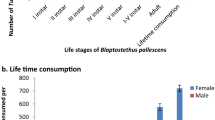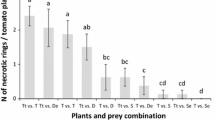Abstract
The anthocorid bug Orius albidipennis Reuter is a generalist predator that feeds on the whitefy Bemisia tabaci Gennadius and the strawberry spider mite Tetranychus turkestani Ugarov & Nikolski in greenhouse crops. There are no previous studies on the potential effcacy of the predatory bug against these pests on greenhouse crops. We report on the effcacy and the prey preference of the predator to control these pests on different host plants under laboratory conditions. In a laboratory experiment, we estimated the predation rates of O. albidipennis at different densities of each prey after 24 h on cucumber and sweet pepper leaves. Predation rates of the predatory bug to T. turkestani and B. tabaci were signifcantly higher on sweet pepper leaf than on cucumber leaf. We studied the effect of plant species on prey preference and switching of O. albidipennis to B. tabaci and T. turkestani using Manly’s α index values and Murdoch’s no-switch line, respectively. Our results show that O. albidipennis prefers T. turkestani to B. tabaci on both host plants but its preference for T. turkestani on sweet pepper is signifcantly greater than on cucumber. Moreover, on sweet pepper, preference values are completely ftted by Murdoch’s no-switch line. The fndings suggest that morphological defence traits of plants, such as hairy leaves of cucumber, may effectively change prey preference and reduce predation success of O. albidipennis.
Similar content being viewed by others
References
Abbot W. S. (1925) A method of computing the effectiveness of an insecticide. Journal of Economic Entomology 18, 265–268.
Akramovskaya E. G. (1978) The biology of some predatory bugs of the family Anthocoridae in the conditions of the Ararat valley in Armenia. Biologicheskii Zhurnal Armenii 31, 959–964.
Ashley J. L. (2003) Toxicity of selected acaricides on Tetranychus urticae Koch (Tetranychidae: Acari) and Orius insidiosus Say (Hemiptera: Anthocoridae) life stages and predation studies with Orius insidiosus. MSc Thesis. Virginia Polytechnic Institute and State University, Virginia, USA. 54 pp.
Breene R. G., Meagher Jnr R. L., Nordlund D. A. and Wang Y.-T. (1992) Biological control of Bemisia tabaci (Homoptera: Aleyrodidae) in a greenhouse using Chrysoperla ruflabris (Neuroptera: Chrysopidae). Biological Control 2, 9–14.
Cheng L. L., Nechols J. R., Margolies D. C., Campbell J. F. and Yang P. S. (2010) Assessment of prey preference by the mass-produced generalist predator, Mallada basalis (Walker) (Neuroptera: Chrysopidae), when offered two species of spider mites, Tetranychus kanzawai Kishida and Panonychus citri (McGregor) (Acari: Tetranychidae), on papaya. Biological Control 53, 267–272.
Chesson P. L. (1984) Variable predators and switching behavior. Theoretical Population Biology 26, 1–26.
Chow A., Chau A. and Heinz K. M. (2008) Compatibility of Orius insidiosus (Hemiptera: Anthocoridae) with Amblyseius (Iphiseius) degenerans (Acari: Phytoseiidae) for control of Frankliniella occidentalis (Thysanoptera: Thripidae) on greenhouse roses. Biological Control 44, 259–270.
Dehghani Zahedani M., Sarafrazi A., Ostovan H. and Mardi M. (2011) Population variation of predatory bug Orius albidipennis (Het: Anthocoridae) in different regions of Iran. Journal of Food, Agriculture and Environment 9, 469–473.
Dicke M., Sabelis W. M. and van den Berg H. (1989) Does prey preference change as a result of prey species being presented together?: Analysis of prey selection by the predatory mite Typhlodromalus pyri (Acarina: Phytoseiidae). Oecologia 81, 302–309.
Eubanks M. D. and Denno R. F. (1999) The ecological consequences of variation in plants and prey for an omnivorous insect. Ecology 80, 1253–1266.
Evans E. D. (2008) The role of predator-prey size ratio in determining the effciency of capture by Anthocoris nemorum and the escape reactions of its prey Acyrthosiphon pisum. Ecological Entomology 1, 85–90.
Hassell M. P. (1978) The Dynamics of Arthropod Predator–Prey Systems. Princeton University Press, New Jersey, pp. 11–23.
Hossini M., Ashouri A., Enkegaard A., Weisser W. W., Goldansaz S. H., Mahalati M. N. and Sarraf Moayeri H. R. (2010) Plant quality effects on intraguild predation between Orius laevigatus and Aphidoletes aphidimyza. Entomologia Experimentalis et Applicata 135, 208–216.
Jaworski C. C., Bompard A., Genies L., Amiens-Desneux E. and Desneux N. (2013) Preference and prey switching in generalist predator attacking local and invasive alien pests. PLoS One 8(12), e82231. doi: 10.1371/journal.pone.0082231.
Jeppson L. R., Keifer H. H. and Baker E. W. (1975) Mites Injurious to Economic Plants. University of California Press, Riverside, USA. 614 pp.
Kamali K., Ostovan H. and Atamehr A. (2004) A Catalog of Mites and Ticks (Acari) of Iran. Islamic Azad University Scientifc Publication Centre, Tehran, Iran, pp. 43–52.
Klečka K. (2010) Predation by aquatic insects: species traits and habitat structure mediate predator–prey interactions. MSc thesis, in English. University of South Bohemia, Ceské Budečjovice, Czech Republic. 30 pp.
Kousari A. A. and Kharazi-Pakdel A. (2006) Preypreference of Orius albidipennis (Het.: Anthocoridae) on onion thrips and two-spotted spider mite under laboratory conditions. Journal of Entomological Society of Iran 26, 73–91.
Krebs C. J., (1989) Ecological methodology. Harper Collins, New York, pp. 321–372.
Krips O. E., Kleijn P. W., Willems P. E. L., Gols G. J. Z. and Dicke M. (1999) Leaf hairs infuence searching effciency and predation rate of the predatory mite Phytoseiulus persimilis (Acari: Phytoseiidae). Experimental & Applied Acarology 23, 119–131.
Lattin J. D. (1999) Bionomics of the Anthocoridae. Annual Review of Entomology 44, 207–231.
Madadi H., Enkegaard A., Brødsgaard H. F., Kharrazi-Pakdel A., Ashouri A. and Mohaghegh-Neishabouri J. (2009) Interactions between Orius albidipennis (Heteroptera: Anthocoridae) and Neoseiulus cucumeris (Acari: Phytoseiidae): Effects of host plants under microcosm condition. Biological Control 50, 137–142.
Manly B. (1974) A model for certain types of selection experiments. Biometrics 30, 281–294. doi:10.2307/2529649.
Montserrat M., Albajes R. and Castañé C. (2000) Functional response of four heteropteran predators preying on greenhouse whitefy (Homoptera: Aleyrodidae) and western fower thrips (Thysanoptera: Thripidae). Environmental Entomology 29, 1075–1082.
Mossadegh M. S. and Kocheili F. (2003) A Semi Descriptive Checklist of Identifed Species of Arthropods (Agricultural, Medical, etc.) and Other Pests from Khuzestan, Iran. Shahid Chamran University Press, Ahvaz, Iran. 475 pp.
Murdoch W. W. (1969) Switching in general predators: Experiments on predator specifcity and stability of prey populations. Ecological Monographs 39, 335–354.
Murdoch W. W. and Marks J. R. (1973) Predation by coccinellid beetles: Experiments on switching. Ecology 54, 160–167.
Nordlund D. A. and Morrison R. K. (1990) Handling time, prey preference, and functional response for Chrysoperla ruflabris in the laboratory. Entomologia Experimentalis et Applicata 57, 237–242.
Oaten A. and Murdoch W. W. (1975) Switching, functional response, and stability in predator–prey systems. The American Naturalist 109, 299–318.
Pericart J. (1972) Hémiptères, Anthocoridae, Cimicidae et Microphysidae de L’Ouest–Paléarctique. Faune Eur Bassin Méditerranéen 7, 398–402.
Price P. W., Bouton C. E., Gross P., McPheron B. A., Thompson J. N. and Weis A. E. (1980) Interaction among three trophic levels: infuence of plants on interactions between insect herbivores and natural enemies. Annual Review of Entomology 11, 41–65.
Price P. W., Denno R. F., Eubanks M. D., Finke D. L. and Kaplan I. (2011) Insect Ecology, Behavior, Populations and Communities. Cambridge University Press, UK. 578 pp.
Reynolds P. (2011) The effects of plant gross morphology on the foraging effciencies of the generalist predators. MSc Thesis. Universityof Waterloo, Waterloo, Ontario, Canada. 80 pp.
Reynolds P. G. and Cuddington K. (2012) Effects of plant gross morphology on predator searching behaviour. Environmental Entomology 41, 516–522. doi: 10.1603/EN11179.
Sobhy I.S., Sarhan A.A., Shoukry A.A. El-Kady G. A., Mandour N. S. and Reitz S. R. (2010) Development, consumption rates and reproductive biology of Orius albidipennis reared on various prey. BioControl 55, 753–765.
SPSS (2007) SPSS Inc. Released 2007. SPSS for Windows, Version 16.0. SPSS Inc., Chicago.
Stansly P. A. and Natwick E. T. (2010) Integrated systems for managing Bemisia tabaci in protected and open feld agriculture, pp. 467–497. In Bemisia: Bionomics and Management of a Global Pest (edited by P. A. Stansly and S.E. Naranjo). Springer, Netherlands.
Tommasini M. G. and Nicoli G. (1996) Evaluation of Orius spp. as biological control agents of thrips pests: Further experiments on the existence of diapause in Orius laevigatus. IOBC/WPRS Bulletin 19, 183–186.
Tschnaz B., Bersier L. F. and Basher S. (2007) Functional response: a question of alternative prey and predator density. Ecology 88, 1300–1308.
van Baalen M., Krivan V., van Rijin P. C. J. and Sabelis M. W. (2001) Alternative food, switching predators, and the presistance of predator-prey systems. American Naturalist 157, 512–524.
Yasunaga T. (1997) The fower bug genus Orius Wolff (Heteroptera: Anthocoridae) from Japan and Taiwan, Part II. Applied Entomology and Zoology 32, 379–386.
Author information
Authors and Affiliations
Corresponding author
Rights and permissions
About this article
Cite this article
Banihashemi, A.S., Seraj, A.A., Yarahmadi, F. et al. Effect of host plants on predation, prey preference and switching behaviour of Orius albidipennis on Bemisia tabaci and Tetranychus turkestani. Int J Trop Insect Sci 37, 176–182 (2017). https://doi.org/10.1017/S1742758416000229
Accepted:
Published:
Issue Date:
DOI: https://doi.org/10.1017/S1742758416000229




